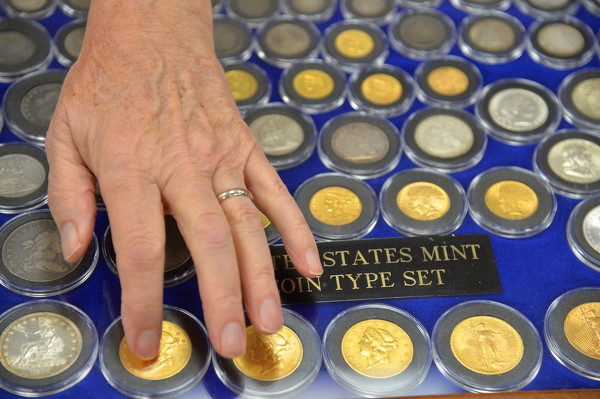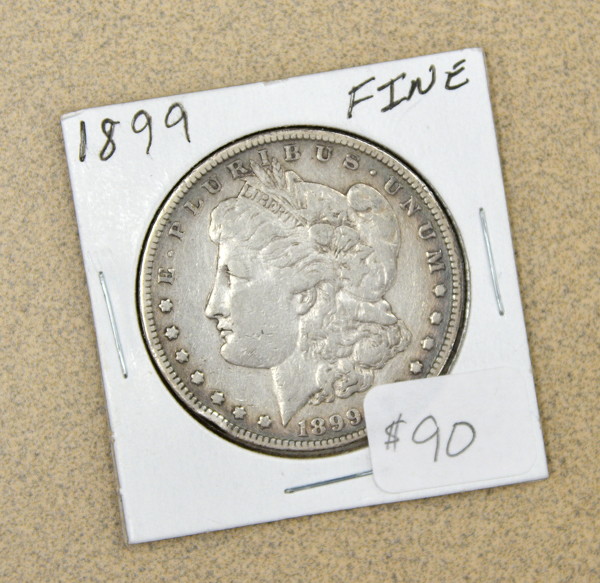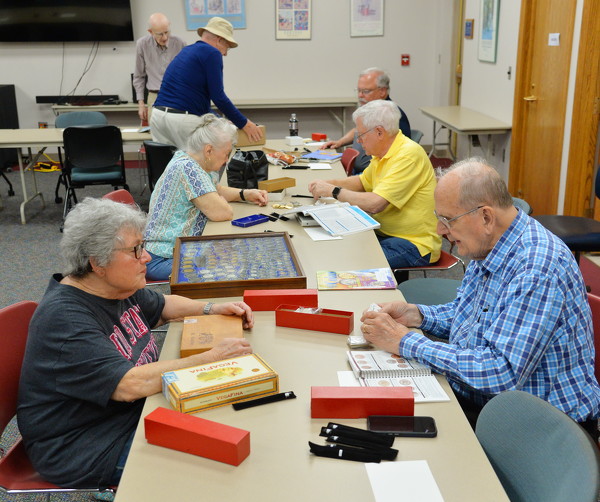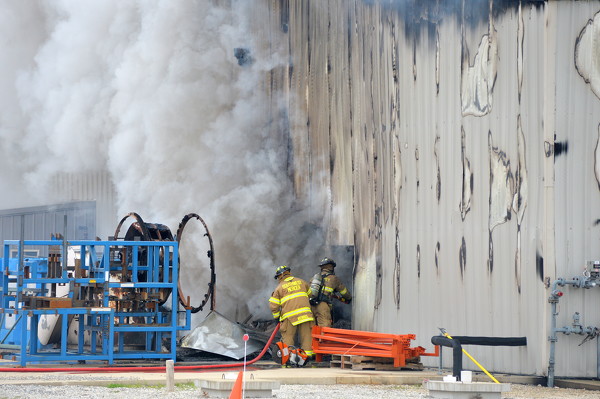Tuesday, April 25th, 2023
Common Cents
Coin club pros grade collections
By Erin Gardner

Photo by Paige Sutter/The Daily Standard
A collection of rare coins owned by Gordon Koffin. The St. Marys Community Public Library welcomed the Tri-county Coin Club to evaluate the public's old and rare coins on Thursday evening.
ST. MARYS - Penny for your thoughts? Gordon Coffin, 81, has many thoughts and quite a few pennies.
The Tri-County Coin Club recently evaluated old and unusual coins brought to the St. Marys Community Public Library.
Coin collecting, like all hobbies, takes time and a great deal of knowledge, Coffin, an Otterbein resident, said.
Several factors, including scarcity, condition, date, mint and type of metal determine a coin's worth.
Most modern coins aren't worth much more than face value because they're made of nickel, copper and zinc, according to the United States Mint. Older coins are made of pure silver or gold. On July 23, 1965, President Lyndon Johnson approved the Coinage Act which removed silver from circulating coins and authorized that clad coins pressed together with multiple metals be used for the half dollar, quarter and dime.
Conversely, collector coins can be valued high as $15 million, Coffin said.

Photo by Paige Sutter/The Daily Standard
Gordon Koffin, Otterbein, examines a coin at the St. Marys Community Public Library Tri-County Coin Club.
Just based on the metal, a 1-ounce silver coin is worth about $25 and a 1-ounce gold coin about $2,000, Coffin said. The price then escalates based on the coin's scarcity, condition and where it was minted.
Today coins are minted in Denver, San Francisco, Philadelphia, Washington. D.C., Fort Knox, Kentucky, and West Point, New York.
"The ones that are going to be the most interesting are the ones where the mints aren't there anymore," Coffin said.
Among the now defunct mints are New Orleans, Carson City, Nevada, Charlotte, North Carolina and Dahlonega, Georgia.
"Charlotte with Dahlonega only made gold coins because that's where the gold was when they were founded back in the 1830s," he said. "When the (Civil War) started, both of them closed down. The south took all the gold … So they were only open for about 30 years. Those coins can be very valuable (because) first they're gold and secondly, they were very short mintage."
At the time when a dime was minted, it was only worth 10 cents. But because it was made of silver it is worth about $1.80 melted down in today's economy, Coffin said.
Because the coin was worth its value, it often corresponded with its size.

Photo by Paige Sutter/The Daily Standard
A dollar coin from 1899.
"In 1796 when that coin was made, it was worth a quarter," Coffin said. "That's really why coins are the size they are because, in the early days, they had to actually be worth their value. That's why a dime is pretty small, a quarter is about twice as much - 50 cents is twice of a quarter."
Additionally, when the silver price fluctuated, the mint had to change the coin "a little bit so they still would be worth a quarter or a half-dollar," he said.
"When silver was low-priced, they actually had to add more silver to the coin to make sure it was still worth 50 cents. They did that by putting (arrows on either side of the mint date) so people would know that they had changed it and it's worth 50 cents," he pointed out.
Coins can be worth more than their face value but that's not the case with modern dol-
lar bills because there's "nothing backing them…they're just paper," Coffin said.
Contrary to popular belief, $2 bills are simply worth $2.
"Everybody thinks $2 bills should be worth something, but they're worth $2. If you want one, I got a couple here. I spend them all the time for tips," he said.

Photo by Paige Sutter/The Daily Standard
John Sacher, Celina, examines a coin's details with a magnifying glass.
However, that's not to say all paper money isn't collectible. Coffin said early paper bills can be valuable based on condition, quality and whose signature they feature.
The majority of Coffin's collection includes larger coins, such as dimes, quarters and $10 and $20 coins. Pennies and nickels aren't necessarily worth anything and cost the government a deficit.
"The government still makes over a billion pennies," Coffin said. "Why in the world are we still making pennies? It costs almost 4 cents apiece to make a penny today. It makes no sense at all to make them. It costs about 8 cents to make a nickel and yet we make billions of them a year."
Even so, pennies and nickels are still in production because of public demand.
Like all hobbyists, Coffin enjoys the idiosyncrasies of coin collecting. He started when he was a child and found it again as an adult.
"Most people outgrew it, (but) some of us never did. I still collect coins," he said.

Photo by Paige Sutter/The Daily Standard
The St. Marys Community Public Library welcomes the Tri-County Coin Club to evaluate the public's old and rare coins on Thursday evening.
It's never too late to start a collection. For coin aficionados and amateurs, the U.S. Mint recommends holding a coin by its edges between a person's thumb and forefinger over a soft towel or surface. Wear soft cotton gloves to protect the coin's surface from fingerprints and natural skin oils, which can be corrosive.
Additionally, the U.S. Mint urges caution when polishing or cleaning coins, which can reduce their value. Older coins that show deep age coloration are more desirable than coins whose surfaces have been stripped away by improper polishing or cleaning.
If a collector does polish a coin to remove dirt, they should use mild soap and water and then pat it dry with a soft towel. Brushing or rubbing can scratch a coin's delicate surface.
Loose change:
• The collection and study of money - paper and coins - is called Numismatics.
• Pennies used to be mostly copper. For a brief period during World War II (1942-1945), pennies were mostly steel with a little zinc.
How much copper is in a penny today?:
• Since 1982, pennies have been mostly zinc with a thin copper plating.
• Half cent, or half penny, is the smallest denomination ever minted in America. It was minted from 1793-1857.
Was there ever a buffalo on a coin?:
Yes. From 1913-1958 a buffalo appeared on a nickel. A Native American in profile was on the other side. Until 1913, the only animal on U.S. money was the eagle.
Correction:
Gordon Coffin's last name was misspelled. The error was due to reporting. The story has been corrected.








